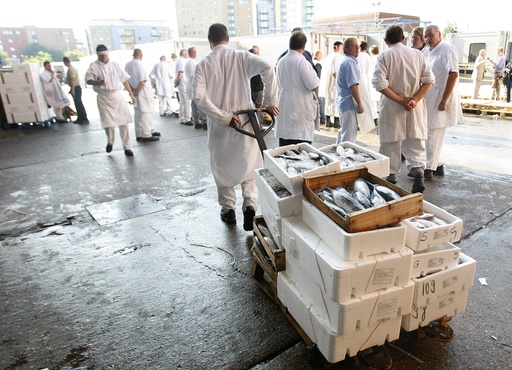
LONDON — The closures of two of London’s iconic markets, the Billingsgate fish market and the Smithfield meat market, loom on the horizon, signaling the end of traditions that date back to the medieval era.
On Wednesday, the governing body of the City of London is expected to submit a bill to Parliament that will terminate its oversight of both markets, which have been operational in various forms since the 11th century.
This decision was made shortly after the corporation opted against relocating the markets to a newly planned development site in Dagenham, located just east of the city.
The relocation was dismissed due to escalating costs spurred by inflation and increased construction expenses, which are projected to rise to approximately 1 billion pounds ($1.25 billion).
As part of a new arrangement with the traders, the City of London Corporation will offer financial support and guidance. The current markets will remain operational until at least 2028, giving traders some time to determine their next steps.
Chris Hayward, the policy chair of the City of London Corporation, expressed optimism about this change, stating, “This decision signifies a positive new chapter for Smithfield and Billingsgate Markets as it empowers traders to create a sustainable future that aligns with their long-term business ambitions. By withdrawing from direct market operations, we aim to foster conditions that allow these businesses to flourish independently.”
The traders are now exploring various options for relocation within London, whether on their own or in collaborative groups.
While any new location will likely be modern and up-to-date, it will inevitably lack the rich traditions associated with the historic markets.
At Smithfield, traders commence their work around 10 p.m., primarily catering to the restaurant sector, and typically finish around 6 a.m., coinciding with the city waking up. Local pubs have historically held special licenses to serve the traders during these early hours.
Prominent author Peter Ackroyd, known for his influential work “London: The Biography,” notes that the origins of Billingsgate fish market trace back to the early 11th century, well before the arrival of William the Conqueror in England. Smithfield emerged shortly thereafter, evolving into a key marketplace for livestock including horses, sheep, and cattle.
Ackroyd recounts how, for centuries, both Smithfield and Billingsgate—alongside other markets selling flowers, fruits, vegetables, and poultry—played an integral role in London’s culture, often associated with rowdy behavior and disorder. The esteemed British novelist Charles Dickens referred to Smithfield as a hub of “filth and mire,” highlighting its nature in works such as “Oliver Twist” and “Great Expectations.”
While the modern iterations of these markets have enacted food standards and undergone renovations, they have shed much of their former squalor.
Conversely, the threat of another expensive reconstruction looms. The structures at Smithfield originate from the Victorian era, although they have been updated over the years and notably suffered a fire in 1958. Meanwhile, Billingsgate has been situated in its current location in London Docklands since 1982, an area that was once neglected but has since transformed into the bustling financial district of Canary Wharf.
Plans are underway to build 4,000 much-needed residential units on the Billingsgate site, while Smithfield’s future holds aspirations for becoming a cultural hub that will host the new London Museum.
